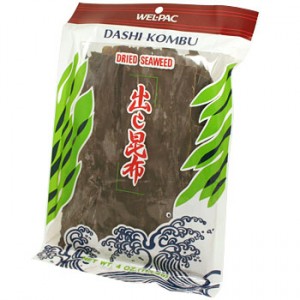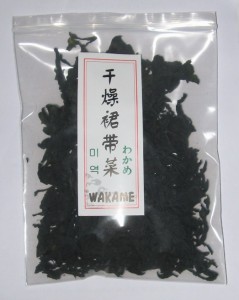Kelp is a group of large, brown seaweeds with the scientific name Laminaria. Kelp is used for human food, especially by the coastal populations of China and Japan. It is very rich in iodine, consequently it is sometimes prescribed to treat deficiencies of that trace element. Some manufacturers of dietary products containing kelp claim that their high levels of iodine act as a weight-reducing agent by increasing the production of thyroid hormones (of which iodine is an essential component) and raising metabolic rate. This would result in excess fat being consumed as an energy source. The claim is unlikely to be true for people who are not iodine deficient. An excessively high iodine intake can be toxic.
Seaweed is an important food source in many Asian cultures, seaweed is a primitive sea plant belonging to the algae family with origins dating back millions of years. Japanese cuisine employs different varieties (such as kombu, laver and nori, a/k/a Korean kim, Irish carrageen and Asian agar) for many uses including soups, vegetables, tea, sushi and as a general seasoning. The Irish are partial to the seaweed known as carrageen, and agar is widely used throughout Asia. Seaweed is a rich source of iodine, an important nutrient. Many seaweeds also provide alginic acid, a jellylike substance that’s used as a stabilizer and thickener in a wide variety of commercially processed foods such as ice creams, puddings, flavored milk drinks, pie fillings, soups and syrups.
 Kombu seaweed, a type of edible seaweed, is the primary source of flavor in Japanese food. It is used in most Japanese foods and is the basis of the seasoning. The unique Umami (savory taste) of Japanese foods cannot be achieved without kombu seaweed, the “secret ingredient.”
Kombu seaweed, a type of edible seaweed, is the primary source of flavor in Japanese food. It is used in most Japanese foods and is the basis of the seasoning. The unique Umami (savory taste) of Japanese foods cannot be achieved without kombu seaweed, the “secret ingredient.”
Seaweeds are becoming more widely known as a healthy food with few calories and rich minerals. Kombu seaweed, however, possesses something that other seaweeds do not. The ability to produce Dashi (stock) is what makes kombu seaweed the “King of Seaweed”. Kombu is a very powerful and useful sea vegetable which can be added to almost anything that is boiled. Once boiled, kombu can be cut in this strips and used in a wide variety of vegetable dishes.
HOW DASHI KOMBU IS MADE
Kombu broth is created by heating kombu strips in water and removing the kombu just before the water boils. This is the basic Japanese soup stock, dashi kombu. Kombu can be used in soups to nutritionally and flavorfully enrich the soup base. The kombu can be left in the soup, cut into thin strips and eaten, or can be removed and flavored in a marinade and served over rice.
For deeper flavor, soak the kombu in the water for 8 hours before boiling, simmer for 20 minutes, then remove from heat.
EASY RECIPE FOR KOMBU SOUP
Add 1 oz. of kombu to 6 cups of water. Bring to boiling and either remove the kombu after 1 minute for a very delicate broth, or simmer for 20 minutes for more flavor. Cut the kombu into thin strips, return the strips to the broth and serve. Vegetables and protein may be added to the broth during cooking. Cubed tofu should be added last, it will heat in the broth. (Serves 4-6)
 WAKAME
WAKAME
Seaweed Salad Uses Wakame, Wakame Stem, Sesame Seed, Kombu, Agar with a dressing. Wakame Seaweed is also known as Alaria esculenta, Alaria marginata, Babberlocks, Bladder Locks, Edible Fucus, Kelp and Winged Kelp.
Wakame is a seaweed that looks and tastes like a slippery spinach. Wakame can be used in the same ways as many other seaweed including in soup and as an addition to green or fruit salads. When dried wakame is soaked in water it expands to at least 10 times its dried size. Parts Used: The whole plant, dried and chopped
WAKAME TYPICAL PREPARATIONS
Place up to 1 oz (30 grams) of wakame in a large bowl or pan you have filled with water and allow to soak for 30 minutes. After the wakame has swollen to a much greater size, remove it from the water and place on a cutting board with the stem facing you.
Cut off the leaves and discard the stem (or save for soup stock). Chop the leaves into bite-sized pieces and dip briefly into boiling water to bring out their color before use. The dried flakes may be liberally applied to most foods.
Eating small amounts of wakame prevents constipation. Recent research has found that some of the fibers in wakame help prevent colon cancer. See link for cancer remedies and more.
Precautions: Don’t use on a daily basis for more than 2 weeks at a time, taking a 2 week break before using again. This will prevent you from overdosing iodine with potential imbalance in thyroid function. For periodic use only and not to be taken for extended periods of time. Not to be used while pregnant.

